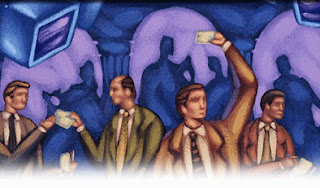I'm now back from "holiday" in NY.
I write "holiday" because the stockmartket was not the best for a calm holiday ;)
With stop losses life is better
From Wikipedia:
Stop orders
A stop order (also stop loss order) is an order to buy (or sell) a security once the price of the security climbed above (or dropped below) a specified stop price. When the specified stop price is reached, the stop order is entered as a market order (no limit).
With a stop order, the customer does not have to actively monitor how a stock is performing. However because the order is triggered automatically when the stop price is reached, the stop price could be activated by a short-term fluctuation in a security's price. Once the stop price is reached, the stop order becomes a market order. In a fast-moving market, the price at which the trade is executed may be much different from the stop price. The use of stop orders is much more frequent for stocks, and futures, that trade on an exchange than in the over-the-counter (OTC) market.
A sell stop order is an instruction to sell at the best available price after the price goes below the stop price. A sell stop price is always below the current market price. For example, if an investor holds a stock currently valued at $50 and is worried that the value may drop, he/she can place a sell stop order at $40. If the share price drops to $40, the broker will sell the stock at the next available price. This can limit the investor's losses (if the stop price is at or below the purchase price) or lock in some of the investor's profits.
A buy stop order is typically used to limit a loss (or to protect an existing profit) on a short sale.[3] A buy stop price is always above the current market price. For example, if an investor sells a stock short hoping the stock price goes down in order to give the borrowed shares back at a lower price (Covering), the investor may use a buy stop order to protect himself against losses if the price goes too high.
A stop-limit order combines the features of a stop order and a limit order. Once the stop price is reached, the stop-limit order becomes a limit order to buy (or to sell) at no more (or less) than a specified price.[4]
As with all limit orders, a stop-limit order may not get filled if the security's price never reaches the specified limit price.
A trailing-stop order is an order entered with a stop parameter that creates a moving or trailing activation price, hence the name. This parameter is entered as a percentage change or actual specific amount of rise (or fall) in the security price. Similarly a trailing-stop-limit order could be entered. Few brokerage firms will accept these orders as they must continuously keep track of the stock price and adjust the stop level.












































